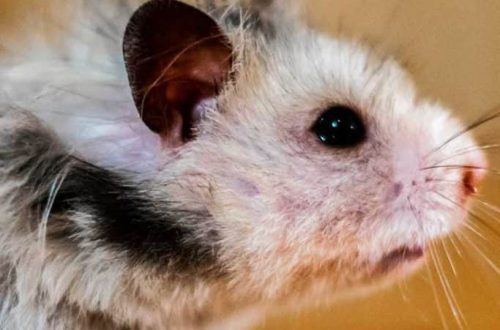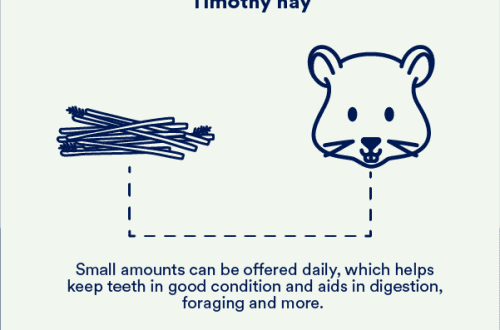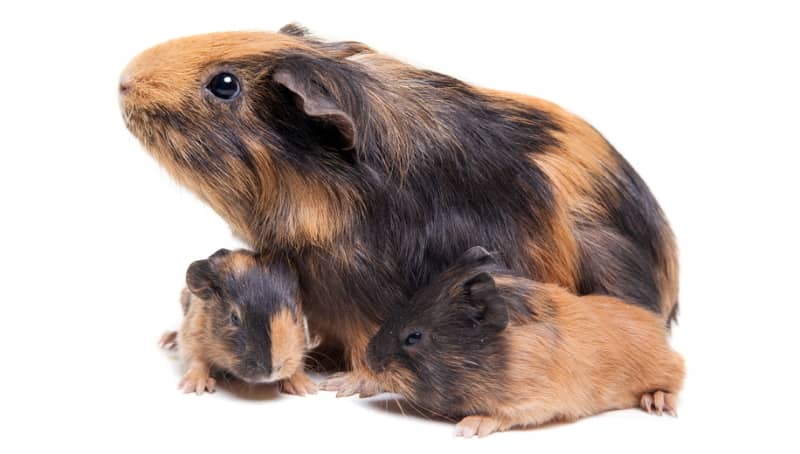
Pregnancy and childbirth in guinea pigs – definition, duration, care of the pregnant and puerperal female
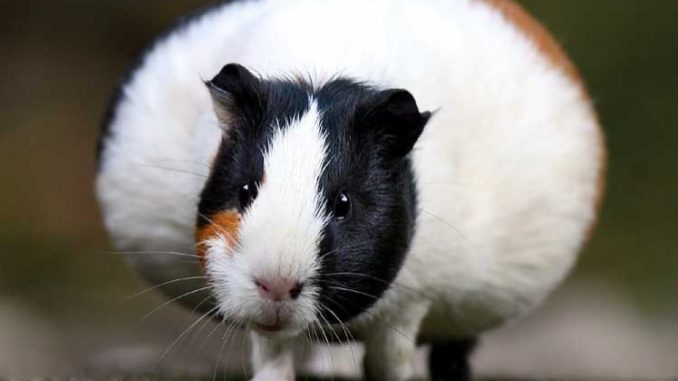
The friendly nature and unpretentiousness in keeping guinea pigs made these funny rodents very popular. Many owners of fluffy pets purposefully acquire individuals of different sexes to get cute offspring at home, sometimes the pregnancy of a guinea pig is unplanned, and newborn babies become a pleasant surprise for pet owners.
Pregnancy and childbirth are accompanied by hormonal changes and high energy costs, so the owner of the future mother needs to properly care for the pregnant guinea pig, create optimal conditions for the birth of small piglets and be ready to provide the necessary assistance to the animal in the pathological course of physiological processes.
Contents
- How to tell if a guinea pig is pregnant
- Video: how to understand that a guinea pig is pregnant
- How long does pregnancy last for guinea pigs?
- How many babies does a guinea pig give birth to
- How to care for a pregnant guinea pig
- What to feed a pregnant guinea pig
- Video: how to care for and how to feed a pregnant guinea pig
- Signs and preparation for the approaching birth of a guinea pig
- How do guinea pigs give birth
- How to help a guinea pig during labor
- Video: preparation and childbirth in a guinea pig
- What to do if the guinea pig gave birth to piglets
- What to feed a guinea pig after childbirth
How to tell if a guinea pig is pregnant
Puberty of guinea pigs occurs at a fairly young age, the female can become pregnant at the age of 3-4 weeks, young males are ready for mating at 2-2,5 months of age. Owners of good-natured animals need to understand that early pregnancy of guinea pigs has an extremely negative effect on:
- on the growth of the female;
- during pregnancy and childbirth due to underdevelopment of the birth canal.
Sometimes a female dies in childbirth along with offspring or refuses to feed newborn babies.
Experts recommend allowing only healthy well-fed young animals with a body weight of 500-700 g, females 10-11 months of age and males at the age of 1 year to be allowed for breeding. Planning pregnancy after 12 months in a female is also undesirable due to ossification of the pelvic ligaments.
It is almost impossible to reliably find out if a guinea pig is pregnant in the early stages, most often there are no signs of pregnancy, and some individuals absolutely do not change their behavior and taste habits until the moment of birth. From the 18th day, you can notice a visual rounding of the abdomen, from this period, during palpation, dense fruits are already felt in the abdomen of a pregnant female. Such a procedure should be carried out by a veterinarian in order to avoid harm to the mother and her offspring.
In the second month of pregnancy, even an inexperienced breeder can determine the pregnancy of a guinea pig by changing the size of the tummy.

The abdomen looks very enlarged and rounded; in case of an unplanned pregnancy, you need to contact a veterinary clinic to exclude bloating. A specialist can confirm the presence of pregnancy by ultrasound. In late pregnancy, an x-ray examination is sometimes prescribed to determine the number and nature of the presentation of the fetus.
Characteristic signs of pregnancy in guinea pigs.
Increase the appetite of a small animal
A pregnant guinea pig drinks a lot more water and eats food to ensure the development of the vital organ systems of future piglets.
No estrus
Estrus in guinea pigs occurs once every two weeks and lasts about a day, during this period the animal bends its back and rumbles when stroked, the rodent’s vagina is swollen and wet.
Behavior change
A pregnant guinea pig behaves less actively, becomes inactive, prefers to hide in the corner of the cage or in the house, sometimes refuses favorite treats or sorts out food, becomes very aggressive towards the male.
Enlargement of the abdomen
From the 3rd week of pregnancy, there is a strong increase in the volume of the guinea pig’s abdomen due to the rapid growth of the fetuses of the animal; from the 7th week, active movements of the fetuses in the abdomen of the pregnant female can be observed.
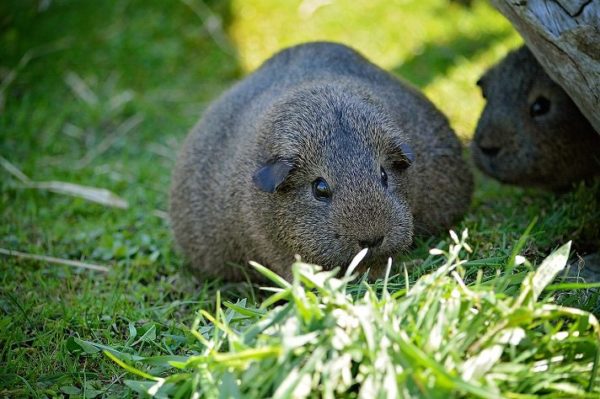
Loop change
The external genitalia swell and increase in size, become loose.
Restroom
An increase in the number of acts of urination and defecation as a result of squeezing the bladder and intestines by an enlarging uterus.
Animal weight gain
A pregnant guinea pig gains a lot of weight from the 4th week of pregnancy, by the time of delivery in the normal course of pregnancy, the female doubles her original weight. Twice a week, it is necessary to carefully weigh the rodent, preferably at the same time, for control, the weighing results must be recorded in a journal.
Weighing should be stopped 2 weeks before delivery to avoid preterm birth. If at a later date the female stops recovering or begins to lose weight, apathy, salivation and ruffled hair are observed, it is urgent to call a veterinarian at home. This period is dangerous for the development of late toxicosis due to lack of nutrients, violation of feeding conditions, stressful situations, most often the pregnant female dies.
Aggression towards relatives
A good-natured and affectionate female during pregnancy is very aggressive towards the male and other females, protecting future cubs.
When confirming pregnancy in a pet, it is necessary to exclude all stressful situations that can cause uterine bleeding or involuntary abortion. It is not recommended to move the cage with the female to a new place, pick up and squeeze the animal, make sharp sounds near the fluffy animal, and often clean the pet’s home.
Pregnancy of healthy guinea pigs with sufficient feeding is characterized by a favorable course, but the owner of a fluffy female needs to prepare in advance for possible pathologies of the animal’s pregnancy. Sudden weight loss, refusal to feed, purulent or bloody discharge from the genitals of a pregnant female, salivation, apathy, muscle lethargy are indications for the appointment of conservation therapy or an emergency caesarean section to save the life of an adult and her babies.
Video: how to understand that a guinea pig is pregnant
How long does pregnancy last for guinea pigs?
On average, guinea pigs carry offspring for 60-68 days, that is, almost 10 weeks. Newborn fluffy cubs are born with open eyes and cut teeth, the kids are completely ready for independent life in the external environment. The gestational age directly depends on how many piglets the female bears, what breed and age the female is. If the expectant mother carries 1-2 babies, the pregnancy sometimes lasts up to 72-75 days. In the case of multiple pregnancies, pregnant guinea pigs walk for 58-62 days. The life span of guinea pigs is about 5 years, with sufficient feeding and comfortable conditions, funny rodents can live up to 8 years, females successfully become pregnant and bear offspring up to 2-3 years, but experts strongly do not recommend using females older than 2 for breeding. -x years of age.
Without harm to health, female guinea pigs should bring no more than 2 litters annually, with a successful pregnancy, it is recommended to put the male in a separate cage for six months so that the female can successfully bear and give birth to babies, as well as restore women’s health after pregnancy and breastfeeding piglets. The male, a day after giving birth, can cover the female who has given birth.
Hormonal restructuring can cause the pathological course of a new pregnancy, the death of the female and her offspring, the refusal of the female to feed newborn cubs.
How many babies does a guinea pig give birth to
Most often, from 2 to 5 cubs are born in the guinea pig litter, primiparous females give birth to no more than 1-2 babies.
Cases of record broods have been registered, when the litter consisted of 7-8 piglets. The female has only one pair of mammary glands, when more than 4 babies are born, all newborns can only survive if there is a foster nursing mother. In the absence of a nursing female or the death of a female during childbirth, the burden of artificial feeding and guardianship of newborn babies falls on the shoulders of the owner of the guinea pig.
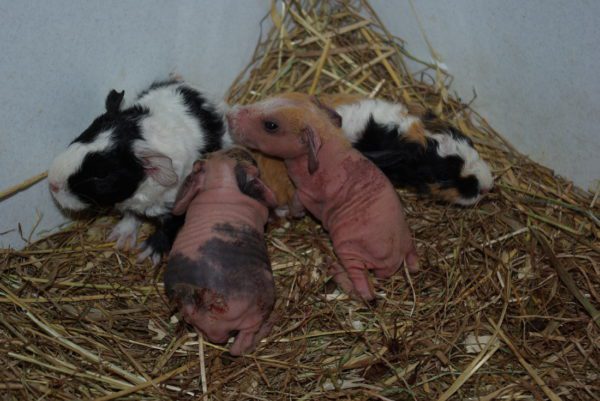
How to care for a pregnant guinea pig
Caring for a pregnant guinea pig is to create optimal feeding and housing conditions for successful pregnancy and safe birth:
- a pregnant female must be kept separately from relatives in a quiet, calm place, preventing the pet from moving and getting direct bright light or drafts into the cage;
- during pregnancy, it is necessary to exclude stressful situations, harsh noises and screams in order to avoid the occurrence of abortions and premature births;
- in the cage of a pregnant female there should be no shelves, hammocks and ladders to avoid traumatic situations;
- during pregnancy, it is highly recommended not to bathe the animal so as not to stress the female once again;
- long-haired individuals at the beginning of pregnancy are recommended to be cut short to reduce contamination of the coat;
- an increase in the volume of the abdomen in a pregnant guinea pig is accompanied by dryness and the formation of microcracks on the skin, which must be lubricated daily with baby cream;
- it is highly recommended not to take a pregnant female once again in your arms, for weighing and examining the animal is removed from the cage, gently bringing your hand under the tight abdomen, sudden movements can cause severe fright and provoke a miscarriage;
- upon the onset of pregnancy, it is advisable to put the male in another cage for six months in order to avoid abortions, premature births and coverage of the female immediately after the birth of the babies;
- X-ray examination of females at a later date is used only if there is doubt or a pathological course of pregnancy, it is recommended to protect shy females from all types of research;
- in case of a successful pregnancy and the absence of stressful situations, it is recommended to arrange short walks for a pregnant female 2 times a day to exclude the development of obesity and congestion;
- in a room with a pregnant female, a constant temperature and humidity should be maintained, excessively dry air, a drop or increase in temperature is fraught with miscarriages, premature birth or the development of toxicosis in the later stages and the death of the female;
- at the bottom of the cage it is necessary to lay a layer of soft alfalfa hay, which is subject to daily change;
- with regular cleaning of the cage, sudden movements or noises are not allowed; a few days before the expected birth, it is recommended to install a nesting house in the cage, lay clean hay and stop access to the rodent’s dwelling;
- during pregnancy twice, and at the end of pregnancy three times, increase the portion of food consumed; for the entire period of pregnancy, childbirth and breastfeeding of newborn babies, it is necessary to carefully monitor the fullness of the drinker with clean drinking water;
- feeders and drinkers must be washed daily and disinfected 2 times a week to avoid the development of intestinal disorders that can cause abortion or death of a pregnant female.
What to feed a pregnant guinea pig
During pregnancy, the body of a female needs a high-calorie diet with an increased content of protein, vitamins and trace elements necessary for:
- correct laying of all vital organ systems of the fetus;
- successful pregnancy and childbirth;
- breastfeeding newborn piglets.
But overfeeding a furry animal is not worth it to prevent obesity and pathological childbirth. A pregnant guinea pig should consume plenty of succulent grass, vegetables and fruits.
The diet of a pregnant guinea pig should consist of the following foods.
Granular feed
It is better to feed pregnant guinea pigs with balanced granular feeds; with separate meals, the animal eats only tidbits, as a result of which all the nutrients necessary for the fetus do not enter the body. The amount of kibble should be given according to the instructions on the package, usually about 1 tablespoon per day. An increase in the amount of combined feed consumed is fraught with the development of obesity. The change of granulated food during pregnancy should be carried out gradually, giving several pieces a day, increasing the daily dosage during the week.
Hay
Pregnant females should be fed with fresh high-quality hay, it is recommended to give timothy grass or garden hay with a green color and a pleasant smell. Moldy, wet or dark hay is not recommended for feeding a future mother to exclude the development of gastrointestinal disorders and poisoning. Expectant mothers are recommended to give daily alfalfa hay, which contains an increased amount of protein and calcium necessary for the proper development of the fetus.
Water
A pregnant female drinks a lot during pregnancy and childbirth; several drinkers with clean drinking water can be installed in the cage.
Vegetables
During pregnancy, you can double the amount of vegetables consumed, one type of vegetable should be given daily. Rodents can be offered carrots, celery, fresh summer tomatoes and cucumbers, corn, zucchini, broccoli, bell peppers.
Herbs
Green juicy herbs are rich in vitamins, which are essential for a pregnant female. The diet of a guinea pig includes: parsley, spinach, lettuce, carrot tops, lupine, alfalfa, sweet clover, clover, plantain, dandelion, sage.
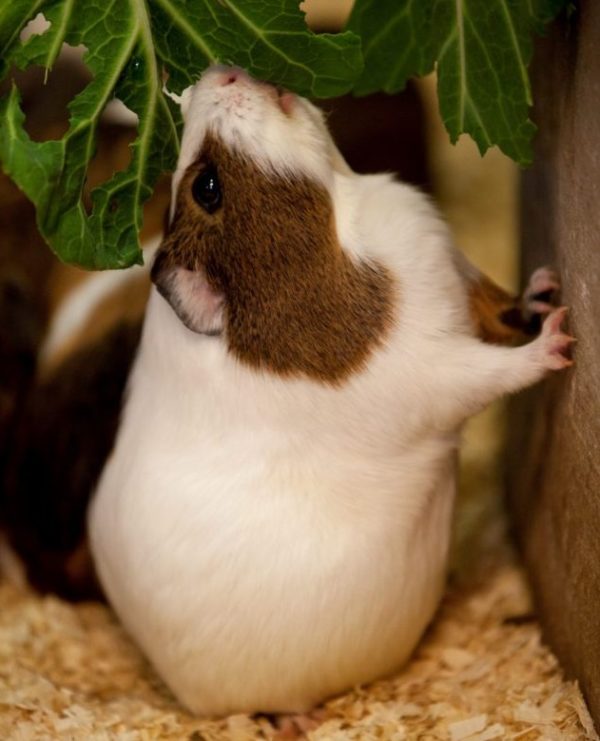
Fruit
Every three times it is recommended to treat the female with a small piece of sweet fruit, it can be an apple, strawberry or grape.
Milk, cottage cheese
Useful protein products of animal origin are given to the pregnant female 2 times a week in limited quantities.
Vitamin C
Tomato juice and rosehip broth are sources of vitamin C necessary during pregnancy.
Vitamin E
Sprouted grains of wheat, oats and barley are a source of reproductive vitamin E.
Vitamins and minerals
The organism of a pregnant guinea pig needs additional introduction into the diet of special supplements containing ascorbic acid and calcium.
It is forbidden to feed a pregnant female with radishes, beets, cabbage, green tomatoes, potatoes and citrus fruits, sorrel, nightshade, ferns, lily of the valley leaves, geraniums.
Video: how to care for and how to feed a pregnant guinea pig
Signs and preparation for the approaching birth of a guinea pig
The owner of a pregnant guinea pig is advised to prepare in advance for the birth of newborn piglets.
Preparing for childbirth
- The owner of a pregnant guinea pig needs to calculate the approximate date of birth himself or ask a veterinarian.
- Before giving birth, it is necessary to install a nesting house or box in the cage, lining it with soft hay or cloth.
- After the 60th day of pregnancy, it is recommended to visually inspect the pelvis of the guinea pig, the expansion of the pelvic bones indicates that the pregnant female will give birth soon.
- The owner must help the giving birth guinea pig and newborns in pathological childbirth, for this it is necessary to prepare in advance a solution of glucose and hydrogen peroxide, gamavit, oxytocin, dicynon, calcium gluconate, clean towels, disposable sterile syringes, saline and milk replacer.
- Before childbirth, it is necessary to pour clean drinking water into the drinkers and carefully monitor their fullness, a lack of moisture during childbirth can cause the death of a newborn offspring.
- The owner of a guinea pig is advised to find a veterinarian in advance who is ready to provide urgent assistance in case of pathological childbirth.
Signs of childbirth
- before childbirth, the guinea pig becomes restless, frightened of all sounds, chases the male, who did not have time to put him in another cage;
- a pregnant female 3-4 days before giving birth intensively builds a nest, often washes herself and cleans her fur, insulates the nesting house or box with hay and wool;
- shortly before giving birth, the female becomes inactive, refuses to eat;
- a week before birth, an expansion of the pelvis is observed, in the body of the female, the birth canal is prepared for the cubs to move along them;
- before and during childbirth, the guinea pig is very thirsty and consumes a huge amount of water;
- you can understand that a guinea pig is giving birth by the characteristic moans that the female makes during contractions.
How do guinea pigs give birth
Childbirth in guinea pigs most often occurs during the quiet night and lasts an average of about an hour. Prolonged births up to 5-6 hours are observed in inexperienced females, with multiple pregnancies or large fetuses.
The guinea pig gives birth in a sitting position, tilting its head forward. Contractions are accompanied by characteristic sounds resembling hiccups. Newborn piglets are born head first with an interval of 5 minutes in the amniotic membranes, which the mother diligently breaks and licks each cub.
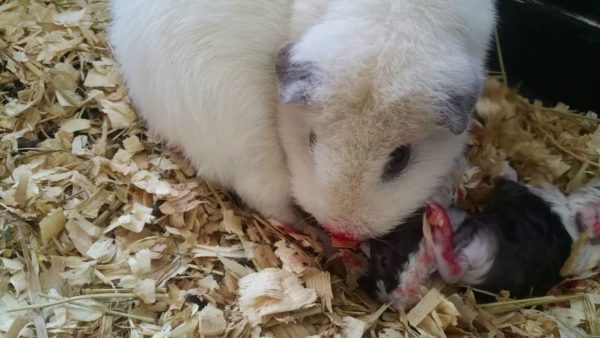
After the guinea pig has given birth, she eats the amniotic membranes, the placenta and feeds the babies with precious colostrum. Small guinea pigs must be dry after childbirth, so as not to get hypothermia. Piglets are born with soft fur, open eyes and cut teeth.
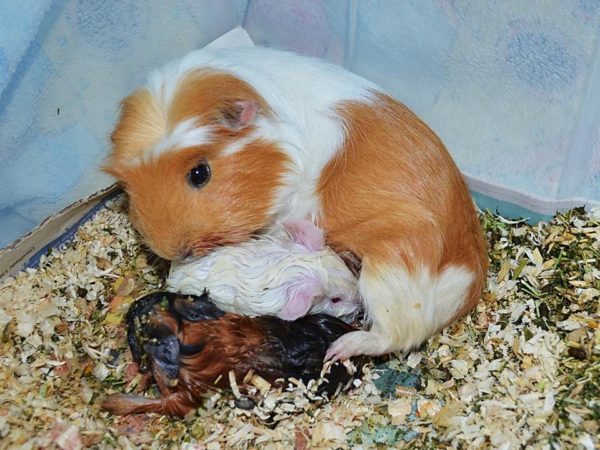
If a guinea pig has given birth to dead babies, the bodies of the newborns must be removed from the cage. The female is very painfully experiencing the situation with stillbirth. Such a case requires an immediate appeal to a veterinarian who will prescribe drugs that stop lactation and conduct an examination to determine the cause of pathological pregnancy and childbirth. The birth of dead babies is observed when:
- early pregnancies;
- infectious diseases;
- violation of the conditions of feeding and maintenance of a pregnant female.
How to help a guinea pig during labor
The birth of a guinea pig sometimes proceeds with various complications that require the immediate intervention of the owner or veterinary specialist.
The female does not have time to break the amniotic membranes
During rapid or first births, the female does not always have time to break the amniotic membranes with her teeth and lick the cubs, which is fraught with the onset of suffocation and death of the newborn. In such a situation, the owner needs to break the fetal membrane with a clean napkin, clean the baby’s nose and mouth from mucus, shake the newborn, wipe it dry with a towel and put it near a bottle of warm water. When the baby begins to move, it is fashionable to carefully shift it into the nest to the mother.
The fetus is stuck in the birth canal
If the fetus is partially stuck in the birth canal, it is recommended to lubricate the baby’s body with vaseline oil and, gently turning clockwise, remove the newborn from the birth canal.
Contractions last over an hour
The female makes loud noises, there is bleeding from the genital tract, salivation and foam from the mouth, the guinea pig looks oppressed. Such situations require immediate professional obstetric care, sometimes an emergency caesarean section is performed to save the life of the female and cubs.
Video: preparation and childbirth in a guinea pig
What to do if the guinea pig gave birth to piglets
If the guinea pig is safely cute babies, you need to create decent conditions for the restoration of mommy’s strength and the growth of newborn offspring.
Guinea pig is very thirsty after giving birth
It is necessary to fill the drinkers with clean drinking water and feed the female a small piece of juicy fruit.
Some females avoid their babies
It is recommended to place the guinea pig with the newborns in the same box so that the mother gets used to it and starts feeding her offspring.
Cage cleaning
After the birth is over, it is necessary to remove the dirty bedding and dead pups, being careful not to touch live pups.
If the newborn is not breathing
It is recommended to rub the back or, holding the piglet in your hand, turn around, when the baby begins to breathe, you must carefully place it in the family nest.
Newborn weighing
A day after birth, it is recommended to carry out daily control weighing of each baby, normally the weight of a piglet is about 70-100 g. For the first three days, the cubs lose weight, by the 5th day there is an increased increase.
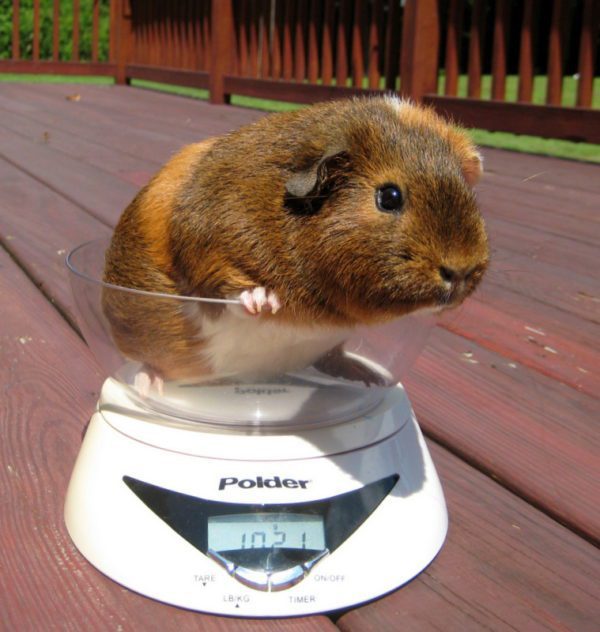
Cell arrangement
The cage with the piglets and the lactating female should be spacious and have a minimum size between the bars, it is recommended to remove the floors so that the guinea pig cannot escape from the offspring.
Examination of the mammary glands
The owner of a lactating guinea pig should conduct a daily examination of the mammary glands to exclude the development of mastitis. With engorgement and blockage of the nipples, it is necessary to gently massage the mammary glands. Try to milk them. Damage to the skin of tender nipples is recommended to be lubricated with petroleum jelly.
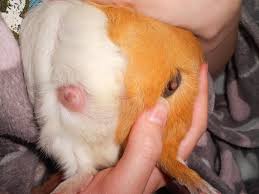
Lack of milk
Sometimes the guinea pig’s mammary glands do not produce enough milk to feed the babies, which causes a decrease in activity and weight gain in babies. In such a situation, the owner of the fluffy offspring needs to independently feed the piglets with infant formula.
Guinea pig won’t eat after giving birth
If, after giving birth, the guinea pig does not eat well, completely refuses food and water, it is urgent to contact a veterinary specialist. Perhaps, during childbirth, a piece of the placenta remained in the uterus, which can cause the development of endometritis, pyometra and the death of the pet.
Availability of water and food in the cage
Babies, repeating after their mother, begin to try rough adult food and hay from the 2nd day of their life. Drinkers should contain enough water for the lactating female and her brood.
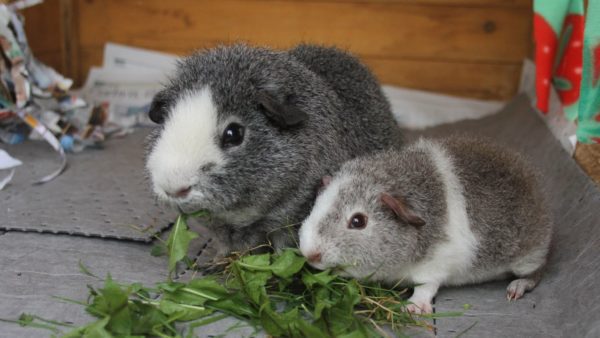
Отсаживание
Young animals are separated from their mother at the age of three weeks in spacious cages, forming groups according to gender.
What to feed a guinea pig after childbirth
A lactating guinea pig needs to be provided with an increased amount of protein and calcium, which are needed to produce enough breast milk. It is recommended that the female who has given birth be fed with juicy green herbs, vegetables, fruits and alfalfa hay, milk and cottage cheese, the amount of dry food for this period can be reduced.
To produce milk, the female must consume a sufficient amount of drinking water, so the owner of the mother is advised to carefully monitor the fullness of the drinkers. Feeders and drinkers must be placed at such a height that babies and mothers can easily reach them.
Breeding guinea pigs at home is a troublesome but exciting process. With a competent approach to the selection of a couple and the observance of the conditions for feeding and keeping a pregnant female, wonderful big-eyed babies are born, who touch with their spontaneity and curiosity from the first days of life.
All about pregnancy and childbirth of guinea pigs
3.3 (65.63%) 32 votes



